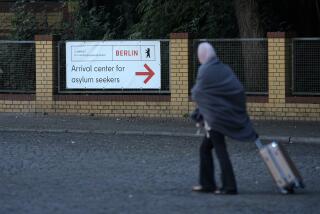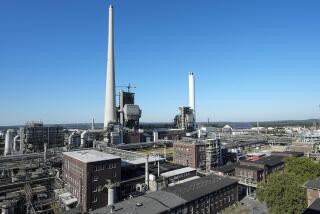COLUMN ONE : Rough Ride for Eastern Germany’s Commuters : Each day, many drive hundreds of miles to the west, where the jobs are. They say they are trapped in the brutal regimen by a two-tiered society.
- Share via
SUCKOW, Germany — When the alarm clock explodes at 6 a.m., Karsten Brunschkewitz hasn’t a moment to spare. The single father of two works on the docks in Hamburg, in what used to be West Germany--normally a two-hour drive from Suckow, in what used to be East Germany. The slightest delay, the least foul-up on the autobahn, and his 12-hour workday, door to door, can stretch to 13 hours or more.
Brunschkewitz won’t risk it. He jumps out of bed, washes, boils some coffee, throws on shorts and a tank top, eats a breakfast of boiled eggs and last night’s salad, and goes downstairs to his maroon Volkswagen Golf in the driveway.
For most of his 34 years, Brunschkewitz could only dream about crossing to the West. The border, marked with watchtowers, barbed wire and anti-vehicle trenches, cut rudely across the lush cropland 50 miles west of his village. Getting a passport was all but impossible.
Today, not only can Brunschkewitz drive from east to west any time he wants--he has to do it, five mornings a week, if he wants a job. He is a pendler , one of hundreds of thousands of eastern German commuters who travel tremendous distances each day to the old West, just to find work.
“My minimum daily driving time is three hours,” says Brunschkewitz, who typically crosses the old Death Strip at 100 m.p.h., trying to cut the 100-mile trip to a life-risking hour and a half. “Once, it took me five hours just to get home.” (Eastern German highways are two lanes each way, so a single accident or construction project--and there are plenty of each--can bring one side to a standstill.)
Of all of the changes to beset eastern Germany since the collapse of the old order in 1989, one of the most poignant has been the rise of the long-haul commuter. Many, like Brunschkewitz, see their children for as little as half an hour a day. Many chance grievous harm in tinny eastern cars on the hair-raising autobahns, which have no speed limits and where 9,000 accidents occur each year.
“For an American, this must be unbelievable,” says Karin Bredemeyer, a Deutsche Bank economist. “You would just move to where the jobs are, wouldn’t you? But it’s a different mentality in Germany. People like to keep to the same place.”
In the summer of 1992, the most recent period for which official statistics are available, 370,000 former East Germans were venturing--exhausted--back and forth to jobs in the former West. Some traveled aboard company-supplied buses; others, like Brunschkewitz, in car pools. Here in the northern state of Mecklenburg Vorpommern, about 37,000 people commute to the former West each day--one of every 23 working adults in the region.
“It’s a terrible strain,” says Anke Thiesler, a onetime secretary in the eastern city of Schwerin who became a long-haul commuter in 1990. Her workday ran from 10 a.m. until after midnight; she finally quit, badly worn down. Now Thiesler works in a Schwerin dress shop by day and moonlights as a cleaning woman, just to get by.
“At least now I’m home by 8 or 9 p.m.,” she says. “If someone had told me before the Wende-- the ‘Great Change’--that I’d one day have to commute such a long way, I’d never have believed them. It was a shock.”
All over the world, people from impoverished countries have long traveled great cross-border distances to improve their circumstances. And in Southern California, some commuters log two hours a day or more.
Former East Germans submit to brutal commuting regimens because they must--even though the notion of free evenings and weekends with one’s family is nothing short of sacred. Chancellor Helmut Kohl promised easterners in 1990 that after unification, “nobody will be worse off and for many, life will be better.” But instead, many easterners believe that they are caught in a two-tiered society in which westerners get all the breaks and easterners are second-class citizens. Long-haul commuting, for them, is just one example.
There is an appalling lack of jobs in the onetime German Democratic Republic. The official unemployment rate in the six states that used to make up East Germany is about 15%, and economists say that if those in make-work programs or those who have given up looking for a job are added in, the effective rate is about 30%. The comparable figure in the former West is 8%.
Another factor is a general reluctance to pull up stakes and move on when opportunities look better elsewhere.
“There are two reasons the Germans don’t move much,” says Detlef Guertler, a journalist with the Berlin newspaper Wochenpost. “One is that it’s terribly hard to find a new apartment in Germany. And the other is something called heimat . It means home, but it also means more than that--it’s a kind of atmosphere, the place where your friends live, where your parents live. A lot of people don’t want to leave their heimat .”
A final motivating force is the gap between wages in the east and the west, even now, nearly five years after the fall of the Berlin Wall. According to a study in the eastern state of Brandenburg, 44% of long-haul commuters there make about $1,600 per month, while 16% of the non-commuting work force earns as much. Across Germany, in many sectors of the economy, unions have negotiated two-tiered pay structures, with one rate for easterners and another for westerners doing the same jobs.
Eastern wages have lagged, in general, because easterners are still perceived as less productive than westerners, and because eastern living costs, while rising sharply, are still thought to be lower.
“They can get away with paying us less because their economic models show that eastern prices are lower,” Brunschkewitz says. “But forget it--it’s not true. The only thing that’s cheaper in the east, at the moment, is the gasoline.”
The Brandenburg study also found that long-haul commuters are, from a managerial point of view, the cream of the labor crop--the people who could most effectively rebuild the former East if they could stay home and do so. Long-haul commuters tend to be young--35 on average--and single or, if married, with at most one or two children. They are well educated, and they tend to take a long view, willing to accept lower wages for a chance at long-term economic opportunity.
“It’s one of the biggest problems in the reunification process,” Guertler says. “The better salaries in the west attract the best workers from the east, and that leaves the people who are less able and less successful in the east.”
All of which makes Brunschkewitz a textbook example. At 34, the divorced father of sons who are 10 and 12, he is a seasoned heavy-equipment operator and mechanic. Before the East German state came undone, he worked in road construction, earning what he calls “an above-average wage.” After reunification, the government paid him $3.60 an hour for road work. Western road workers, he says, made $10 an hour.
That was when he heard that Barthels & Lueders, a subsidiary of the giant Blohm & Voss shipyard in Hamburg, where the Elbe River flows into the North Sea, had a truck-repair department. A fellow easterner had recently gone to work there, and he was looking for car-pool partners. Brunschkewitz rushed to apply for a job and has been car-pooling ever since.
At exactly 7 a.m., Brunschkewitz pulls out of the driveway of his small family farm. It’s quiet except for a few storks in the trees; Suckow is a village of just two houses, and no one at the neighboring farm is awake yet.
He heads up a low hill to a poured-concrete apartment building, where 27-year-old Thoralf Richert is waiting. Richert is also a father of two and a mechanic. He once repaired farm equipment. Today he also fixes trucks. He has come equipped for the long drive with newspapers and a computer game.
“You can get used to commuting, but it’s better to do it with three people, and not alone,” Brunschkewitz says. “It’s less boring and you can save money on gasoline.”
He crosses an overpass, pulls onto the highway and accelerates to a neat 95 m.p.h., standard commuting speed on the autobahn. The tires thud alarmingly on the rough pavement. The speed limit in the former East is 80 m.p.h., but many easterners drive as if they were on the better western highways. Commuting by autobahn can be a breathtaking experience--at least when the traffic is moving.
Today it isn’t. After a half-hour, Brunschkewitz slams on the brakes. Traffic has stopped, and a line of trucks and cars stretches up a hill out of sight. People have turned off their engines and are pacing the hot asphalt.
Brunschkewitz curses. He and Richert are supposed to work a nine-hour shift; if they come late, the company will dock their pay. He walks up the road and comes back to report a big accident up ahead. Accidents in the former East can block highways for hours. There is no choice but to sit until the tow trucks come.
“Maybe we’ll have to work overtime,” Richert says.
“It’s already so late when we get home in the evenings,” Brunschkewitz says. “It used to be better, because there was an early shift. We worked only seven hours, and we could still be home by 5. Now we come in a little later, we work a longer shift, and we don’t get home until at least 8.” His children go to bed at 8:30.
Mercifully, the tow trucks come quickly. The accident is cleared, and at precisely 9 Brunschkewitz is peeling into the Barthels & Lueders parking lot. He and Richert hurry inside, change into long pants and blue work aprons and punch in. They are right on time.
Three floors above, in sunny executive offices, Barthels & Lueders CEO Rainer Volckmann reflects on the situation.
“Why do they commute?” he asks jovially. “That’s easy--they need the money. They are a lot luckier than the people who don’t have the chance to drive these great distances. A lot of people are out of work in the former East.”
In the beginning, when he started hiring easterners, Volckmann says, he sensed a cultural gap between them and the western mechanics. “They spoke the same language, but there were different ideas in their minds,” he says. “Work hours, for instance. In the German Democratic Republic, it wasn’t really necessary to work all day. They got paid no matter what. Here, they have to worry about it.”
But all that is behind them, Volckmann says. “Today, you can see no difference between them. And there is no difference in pay.” The Barthels & Lueders bargaining group, which mediates between management and the work force, forbids that, he says.
Across Germany, economists are at a loss to estimate how long it may be before the eastern unemployment rate approaches the western one--if ever. The eastern economy, which hit bottom in 1992 and 1993, is showing signs of growth. Privatization of the old eastern industrial stock is supposed to be finished by year’s end, and the government is extending its programs of subsidies and tax breaks for investors willing to take a plunge into the old East.
But none of these signs spell much relief for the unemployed.
“There are high labor costs in eastern Germany, and it’s hard to lay people off,” says Bredemeyer, the Deutsche Bank economist. “So investors think about capital investment, and not about employment. They try to hire the least number of people possible. I don’t think we’ll ever see complete equalization of unemployment.”
It’s 10 before 6. Brunschkewitz leaves the shop floor, changes into his shorts, punches the clock, heads to the car. He and Richert ride the stoplights east through a charmless landscape of rail yards, cranes, fuel tanks and power lines.
Brunschkewitz will have dinner to cook when he gets home, he says. Then he will drive to a friend’s house to help plaster walls. At 7:45, he drops off Richert, then heads to his farm. His sons and his mother are waiting. It hasn’t been a bad day: just 12 hours and 45 minutes, door to door.
The boys follow Brunschkewitz upstairs to the kitchen and wait while he boils coffee. His mother, Vera, an unemployed biology teacher, offers her thoughts on the plight of the east: “There’s not going to be any jobs for anybody around here for the next generation,” she predicts.
A firm socialist even now, she says unhesitatingly that she thinks the family was better off in the old days. Her husband used to work on a farming collective; now he is jobless. Her lathe-operator daughter may never work again. She sees her grandsons’ schoolmates running wild, their parents turning to alcohol, marriages failing.
“We have to have more solidarity,” she says. “We have to treat each other better. And we need reindustrialization, to provide jobs and rebuild some pride for the people around here.”
Her son sees things differently: He has a job, no matter how stressful it may be, and so he feels better off than before.
“But it’s just a job,” he adds. “If I could find anything else, I’d take it. I’ve applied to other places right here near Suckow, and they liked me, but no one around here is hiring right now.”
He knows, he adds, that Barthels & Lueders wants to get out of the truck-repair business and may close his department this year. Then he too will join the ranks of the eastern unemployed.
“If that happens, then I’ll look for a new job,” he says. “Maybe something in agriculture. But whatever I find, it will definitely be here in the area. I never want to drive so far again.”
Next: Westerners move east.
More to Read
Sign up for The Wild
We’ll help you find the best places to hike, bike and run, as well as the perfect silent spots for meditation and yoga.
You may occasionally receive promotional content from the Los Angeles Times.






